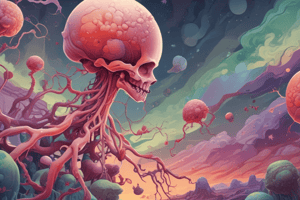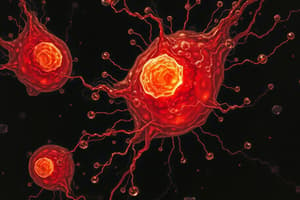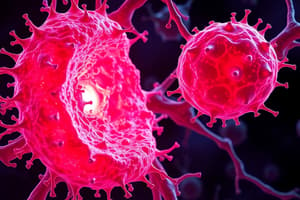Podcast
Questions and Answers
What is the main distinction between invasiveness and metastasis in cancer?
What is the main distinction between invasiveness and metastasis in cancer?
- Invasiveness involves tumor growth past normal tissue boundaries. (correct)
- Invasiveness refers to cancer cells spreading to distant sites.
- Metastasis is the growth of cancer cells within their original site.
- Metastasis is characterized by localized excessive cell growth.
Which type of cancer is typically classified as benign due to its naming convention?
Which type of cancer is typically classified as benign due to its naming convention?
- Lymphomas
- Sarcoplasmas
- Carcinomas
- Omas (correct)
What characterizes dysplasia in tissue architecture?
What characterizes dysplasia in tissue architecture?
- Abnormal cytological changes and disorganization. (correct)
- Excessive normal cell growth without changes.
- Replacement of one type of cell layer with another normal type.
- Complete normalcy of cell structure and function.
Stage 3 cancer is associated with what level of survival prognosis?
Stage 3 cancer is associated with what level of survival prognosis?
Among the following, which cancer type does NOT typically metastasize?
Among the following, which cancer type does NOT typically metastasize?
What does neoplasia refer to in the context of cancer?
What does neoplasia refer to in the context of cancer?
What is the primary cause of death due to cancer?
What is the primary cause of death due to cancer?
Which statement accurately defines hyperplasia?
Which statement accurately defines hyperplasia?
What is a defining feature of oncogenes that differentiates them from tumor suppressors?
What is a defining feature of oncogenes that differentiates them from tumor suppressors?
Which pathway is primarily modulated by Ras and is involved in cancer signaling?
Which pathway is primarily modulated by Ras and is involved in cancer signaling?
How does Myc contribute to the progression of cancer?
How does Myc contribute to the progression of cancer?
Which of the following factors is NOT considered a potential cause of cancer?
Which of the following factors is NOT considered a potential cause of cancer?
The Ames Test is known for its ability to detect what type of mutations?
The Ames Test is known for its ability to detect what type of mutations?
What is a major limitation of the Ames Test?
What is a major limitation of the Ames Test?
The concept of monoclonal tumors indicates that these tumors arise from:
The concept of monoclonal tumors indicates that these tumors arise from:
Which cancer type has been associated with the mutation of the N-Ras oncogene?
Which cancer type has been associated with the mutation of the N-Ras oncogene?
What is the primary mechanism through which oncogenic Myc is activated in cancer?
What is the primary mechanism through which oncogenic Myc is activated in cancer?
What does the Two-Hit Hypothesis propose regarding tumor suppression?
What does the Two-Hit Hypothesis propose regarding tumor suppression?
What is the role of BH3-only proteins in the apoptotic process?
What is the role of BH3-only proteins in the apoptotic process?
How does Akt influence cellular processes in relation to apoptosis?
How does Akt influence cellular processes in relation to apoptosis?
What is a primary consequence of overexpression of pro-survival Bcl proteins?
What is a primary consequence of overexpression of pro-survival Bcl proteins?
Which model describes how p53 differentiates between activating cell cycle arrest and apoptosis?
Which model describes how p53 differentiates between activating cell cycle arrest and apoptosis?
What role does Smac/Diablo play in the apoptotic signaling pathway?
What role does Smac/Diablo play in the apoptotic signaling pathway?
What is the main consequence of Rb loss-of-function mutations in relation to tumor suppressor activity?
What is the main consequence of Rb loss-of-function mutations in relation to tumor suppressor activity?
How does the Two-Hit Hypothesis explain the development of hereditary retinoblastoma?
How does the Two-Hit Hypothesis explain the development of hereditary retinoblastoma?
What role does p53 play in cellular response to DNA damage?
What role does p53 play in cellular response to DNA damage?
What can result from a missense mutation in the p53 gene?
What can result from a missense mutation in the p53 gene?
What is a primary function of the retinoblastoma protein (Rb) in the cell cycle?
What is a primary function of the retinoblastoma protein (Rb) in the cell cycle?
What mechanism primarily regulates p53 activity in response to stress conditions?
What mechanism primarily regulates p53 activity in response to stress conditions?
What is the consequence of the inactivation of the Rb protein in cells?
What is the consequence of the inactivation of the Rb protein in cells?
Which of the following is NOT a target gene regulated by p53?
Which of the following is NOT a target gene regulated by p53?
How does cyclin-CDK activity affect Rb?
How does cyclin-CDK activity affect Rb?
What cellular event occurs when p53 accumulates in response to DNA damage?
What cellular event occurs when p53 accumulates in response to DNA damage?
Which kinase is NOT involved in the phosphorylation of p53 that impairs its binding to MDM2?
Which kinase is NOT involved in the phosphorylation of p53 that impairs its binding to MDM2?
What role does p19ARF play in relation to p53 and MDM2?
What role does p19ARF play in relation to p53 and MDM2?
Which is a characteristic feature that distinguishes embryonic stem cells from adult stem cells?
Which is a characteristic feature that distinguishes embryonic stem cells from adult stem cells?
Which of the following statements about death receptors is true?
Which of the following statements about death receptors is true?
What differentiates cancer stem cells from normal stem cells?
What differentiates cancer stem cells from normal stem cells?
Which of the following best describes the function of FLIP in death receptor signaling?
Which of the following best describes the function of FLIP in death receptor signaling?
Which of the following factors is involved in maintaining the 'stemness' of stem cells?
Which of the following factors is involved in maintaining the 'stemness' of stem cells?
What may lead to the transformation of normal stem cells into cancer stem cells?
What may lead to the transformation of normal stem cells into cancer stem cells?
Which pathway is characterized by the ligand FasL binding to its receptor to induce apoptosis?
Which pathway is characterized by the ligand FasL binding to its receptor to induce apoptosis?
Flashcards
Cancer
Cancer
A group of diseases affecting multicellular species, characterized by unregulated tissue growth forming tumors.
Metastasis
Metastasis
Spread of cancer cells to and growth in foreign sites, a key feature in many cancers.
Invasiveness
Invasiveness
Cancer cells growing beyond normal tissue boundaries in their original location.
Hyperplasia
Hyperplasia
Signup and view all the flashcards
Metaplasia
Metaplasia
Signup and view all the flashcards
Dysplasia
Dysplasia
Signup and view all the flashcards
Neoplasia
Neoplasia
Signup and view all the flashcards
Staging of cancer
Staging of cancer
Signup and view all the flashcards
Cancer development
Cancer development
Signup and view all the flashcards
Monoclonal cancer
Monoclonal cancer
Signup and view all the flashcards
Leiomyomas
Leiomyomas
Signup and view all the flashcards
Myelomas
Myelomas
Signup and view all the flashcards
Ames Test
Ames Test
Signup and view all the flashcards
Oncogene
Oncogene
Signup and view all the flashcards
Tumor Suppressor
Tumor Suppressor
Signup and view all the flashcards
Ras protein
Ras protein
Signup and view all the flashcards
Myc protein
Myc protein
Signup and view all the flashcards
MAP kinase pathway
MAP kinase pathway
Signup and view all the flashcards
Intrinsic (mitochondrial) pathway
Intrinsic (mitochondrial) pathway
Signup and view all the flashcards
Bcl-2 family
Bcl-2 family
Signup and view all the flashcards
Warburg effect
Warburg effect
Signup and view all the flashcards
Akt
Akt
Signup and view all the flashcards
Apoptosome
Apoptosome
Signup and view all the flashcards
p53 and MDM2 interaction
p53 and MDM2 interaction
Signup and view all the flashcards
p19ARF's role
p19ARF's role
Signup and view all the flashcards
Myc and Ras's role
Myc and Ras's role
Signup and view all the flashcards
What defines a stem cell?
What defines a stem cell?
Signup and view all the flashcards
Stem cell progeny
Stem cell progeny
Signup and view all the flashcards
Pluripotent vs. Multipotent
Pluripotent vs. Multipotent
Signup and view all the flashcards
Mutations in c-kit
Mutations in c-kit
Signup and view all the flashcards
How do stem cells divide?
How do stem cells divide?
Signup and view all the flashcards
Hematopoietic stem cell model
Hematopoietic stem cell model
Signup and view all the flashcards
Origin of cancer stem cells
Origin of cancer stem cells
Signup and view all the flashcards
Two-Hit Hypothesis
Two-Hit Hypothesis
Signup and view all the flashcards
Loss of Heterozygosity (LOH)
Loss of Heterozygosity (LOH)
Signup and view all the flashcards
Rb: What makes it a tumor suppressor?
Rb: What makes it a tumor suppressor?
Signup and view all the flashcards
E2F: What are they?
E2F: What are they?
Signup and view all the flashcards
How does Cyclin/Cdk complex affect Rb?
How does Cyclin/Cdk complex affect Rb?
Signup and view all the flashcards
What happens when Rb is inactivated?
What happens when Rb is inactivated?
Signup and view all the flashcards
p53: What is its function?
p53: What is its function?
Signup and view all the flashcards
How does p53 work?
How does p53 work?
Signup and view all the flashcards
What are the effects of p53 inactivation?
What are the effects of p53 inactivation?
Signup and view all the flashcards
How is p53 regulated?
How is p53 regulated?
Signup and view all the flashcards
Study Notes
Introduction to Cancer
- Cancer is a group of diseases affecting multicellular species.
- Cancer causes death through organ destruction, infections (due to immune system impairment), cachexia, and hemorrhage.
- Cancer cells grow through tissue, forming tumors.
Invasiveness vs. Metastasis
- Invasiveness: Cancer cells grow beyond normal tissue boundaries, often within connective tissue capsules.
- Metastasis: Cancer cells spread and grow in new locations. A hallmark of malignancy, although some cancers are highly invasive but don't metastasize (e.g., gliomas, basal cell carcinomas).
Cancer Types and Terminology
- Hyperplasia: Excessive cell growth; cells are typically normal.
- Metaplasia: Replacement of one cell type with another.
- Dysplasia: Abnormal cells characterized by altered size/shape (nucleus), increased mitosis, and cytoplasmic changes; a transitional state between benign and premalignant.
- Neoplasia: Abnormal/disorganized growth forming a mass (both malignant and nonmalignant).
- Anaplasia: Dedifferentiated tumor cells; tissue origin is indistinguishable.
- "-oma" suffix usually associated with benign tumors.
Cancer Staging and Prognosis
- Cancer staging reflects prognosis.
- Stage 1: High survival (75-90%)
- Stage 2: Moderate survival (45-55%)
- Stage 3: Low survival (15-25%)
- Stage 4: Very low survival (<5%)
Major Cancer Classifications
- Carcinoma: Most common; epithelial origin.
- Sarcoma: Connective/mesenchymal tissue origin.
- Leukemias/Lymphomas: Blood (hematopoietic) cell origin.
- Neuroectodermal: Glioblastomas, neuroblastomas, Schwannomas.
Cancer as a Genetic Disease and Aging
- Cancer development requires multiple genetic changes.
- Inherited mutations influence risk, but additional factors are necessary for cancer development.
- Cancer incidence is strongly correlated with age (e.g., colon cancer).
Cancer as a Monoclonal Disease
- Cancer arises from a single mutated cell.
- Examples: Leiomyomas (uterine wall) and myelomas (B cell precursors).
Cancer Epidemiology/Causative Factors
- Viral infections
- Carcinogens (physical and chemical)
- Lifestyle factors influence cancer prevalence globally.
Ames Test
- The Ames test measures the frequency of back mutations in Salmonella strains requiring histidine.
- Strengths include simplicity, sensitivity to mutagens, and use of metabolic activation.
- Limitations include prokaryotic system, inherent false positives/negatives, and limited scope, missing non-mutagenic carcinogens.
Hallmarks of Cancer
- Cancer cells exhibit characteristic features, like uncontrolled growth, resistance to cell death, and ability to metastasize.
- Tumor biology is influenced by surrounding stromal tissues. Understanding stromal influences is important for treatment.
Oncogenes (Lecture 2)
- Oncogenes cause uncontrolled growth through gain-of-function mutations.
- Tumor suppressor genes are inactivated by loss-of-function mutations.
Proto-oncogene Transformation Mechanisms
- Quantitative: Gene amplification (e.g., MYC, HER2).
- Qualitative: Point mutations (e.g., RAS).
RAS Protein
- RAS is a small GTP-binding protein involved in many signaling pathways, like the MAP kinase pathway.
- Mutations in RAS, lock it in an "on" state, leading to cancer.
- It is found in several cancer types, including pancreatic, lung, and colon cancers.
MYC Protein
- MYC is a transcription factor regulating cell growth and proliferation.
- Aberrant expression (amplification or translocation) can drive oncogenesis.
- Myc is implicated in a multitude of cancers.
MAP Kinase Pathway Components and Cancer
- Mutated components of the MAP kinase pathway can contribute to cancer, including ERBB2/HER2, RAF, and NF-1.
Targeted Therapies for Oncogenes
- Therapy targeting the activity of RAS and MYC is a primary focus. Often involves small molecule inhibitors to limit activity.
Tumor Suppressors (Lecture 3)
- LOH (Loss of Heterozygosity): Loss of one copy of a tumor suppressor gene.
- Two-Hit Hypothesis: Usually requires the inactivation of both alleles of a tumor suppressor gene to develop a tumor. This highlights the importance of both genes.
RB Protein and its Function
- RB plays a crucial role in regulating the cell cycle by controlling the restriction point, and is often inactivated in cancer.
- RB normally prevents cells from passing to the next phase and becoming cancerous, blocking E2F gene transcription.
P53 Protein and its Function
- P53 is a key tumor suppressor, acting as a "guardian angel" by inducing cell cycle arrest or apoptosis in response to stress, like DNA damage.
- It's frequently inactivated or mutated in cancer, allowing unchecked cell growth.
P53 Activation and Regulation
- P53 levels are normally kept low through quick degradation.
- Stress leads to accumulation of p53 for proper cellular response.
- MDM2 is an oncoprotein that interacts with and regulates p53 levels.
Cancer Stem Cells (Lecture 4)
- Stem cells are characterized by self-renewal and the ability to differentiate into various cell types.
- Cancer stem cells are a subset of abnormal cells within a tumor that can proliferate and maintain the cancer.
Distinguishing Cancer Stem Cells
- Cancer stem cells often possess distinct surface markers (e.g., CD44, CD24) compared to typical cancer cells using FACS to distinguish.
- Cancer stem cells are more resistant to traditional cancer therapies and often drive tumor recurrence.
Apoptosis and Cancer (Lecture 5)
- Apoptosis: Programmed cell death.
- Necrosis: Uncontrolled cell death.
Pathways of Apoptosis
- Intrinsic (Mitochondrial) Pathway: Activated by cellular stress, involving Bcl-2 family proteins (Bax, Bak, Bcl-2) that regulate mitochondrial membrane integrity.
- Extrinsic (Death Receptor) Pathway: Activated by external signals (ligands binding specific receptors). The receptor pathway relays information to activate the caspase proteins involved in apoptosis.
Warburg Effect
- Cancer cells have increased glucose uptake and metabolic activity, driving glycolysis instead of oxidative phosphorylation in situations of abundant glucose.
p53's Role in Apoptosis vs. Arrest
- p53 can induce apoptosis when stress is severe, or cell cycle arrest in those situations of milder stress. Which pathway p53 activates depends on the level of stress faced by the cell.
Studying That Suits You
Use AI to generate personalized quizzes and flashcards to suit your learning preferences.




